Reptile enthusiasts love the veiled chameleon for their vividly bright colors.
This pet lizard has a unique ability to change their color based on and receptivity. They do this by changing between brighter and duller skin colors.
They originate from the Arabian Peninsula and have established colonies in Hawaii and Florida.
Also known as the Yemen Chameleon this species can grow to up to two feet and costs $50 – $200.
Want to learn more about veiled chameleons and why they are one of the most popular pet lizards? Read on to find out more…
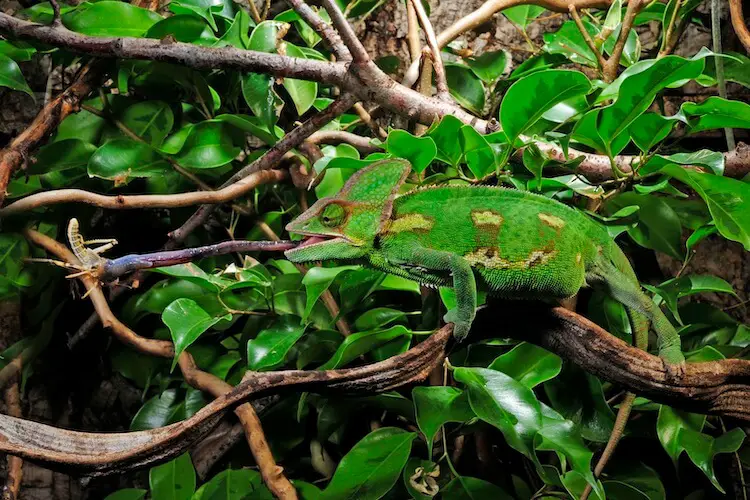
Veiled Chameleon Overview
Veiled chameleons originate in the Arabian Peninsula and thrive in treetops because they are arboreal.
They are named after the distinctive crest on their head.
This chameleon has a very long tongue that is used to catch prey. Their tongue measures 1.5 times the length of their body and can be “shot” out in the blink of an eye. It has a muscle that spreads and grabs their prey.
Another interesting fact about the veiled chameleon is their eyes.
Their eyes move independently, so they can look in two directions at once. Each eye can swivel 180 degrees to allow them to look in any direction without moving their body.
This reptile comes in many unique colors and patterns. Their color can reflect their mood as the brighter their skin color the more aggressive or happy they are. Their color also changes based on their receptivity willingness (or lack of).
Contrary to popular belief they cannot change their color but the brightness of their skin.
This means that placing different colored backgrounds in their cage will not cause a veiled chameleon to become that color.
What We Like About Veiled Chameleons
Pros
- They are very beautiful, colorful and exciting to look at.
- This lizard is slow moving, calm, and very happy being left alone.
- They have a long lifespan of between five to eight years.
Cons
- They have aggressive tendencies and don’t like to be handled.
- It can be difficult and expensive to create their habitat.
- They suffer from many health issues and it can be difficult to find a vet that specializes in Chameleons.
Species Appearance

The veiled chameleon is normally a bright colored pastel green.
They are born pastel green and develop bold bands of color that circle their body as they age.
There is are big differences between male and female veiled chameleons that makes it very easy to tell the difference:
- When fully grown males are larger in body size and are more brightly colored. Males also have a tarsal spur – a small nub on their back foot.
- Females have a smaller casque and their color is usually more mottled.
Chameleons have thin tall bodies that are roughly leaf-shaped. They also have a bony ridge on the top of their heads called a casque. These ridges can grow to 2 inches.
Veiled Chameleon Colors
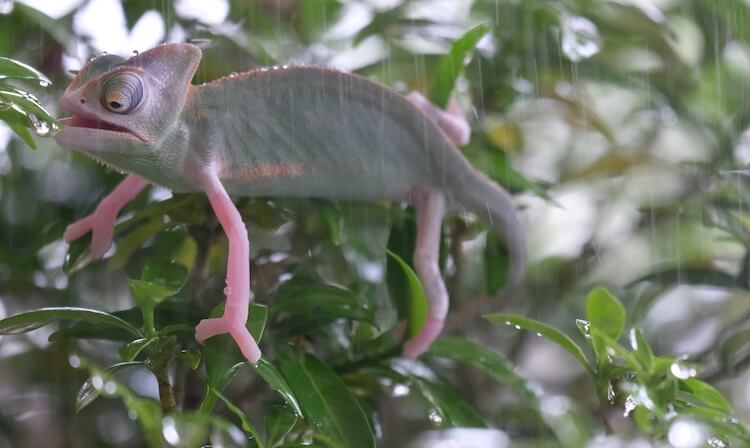
There are no specific color variations for this lizard. Even hatchlings from the same clutch can be different colors.
Male veiled chameleons are normally bright gold, green, or blue with bands of yellow, orange, or black.
Females are not as colorful as males and normally have a green base color.
There is a also a variation known as the translucent veiled chameleon (pictured above). The translucent is slightly paler due to a pigment deficiency.
Translucent chameleons are more expensive and are increasingly common as breeders are able to breed this trait.
How Big Do Veiled Chameleons Get?
Fully grown in under a year male chameleons are between 17 – 24 inches from their head to the tip of their tail. Females are slightly smaller and measure 10 – 14 inches.
Males weigh three to six ounces and females are smaller at between three to four ounces.
Veiled Chameleon Care & Husbandry Guide
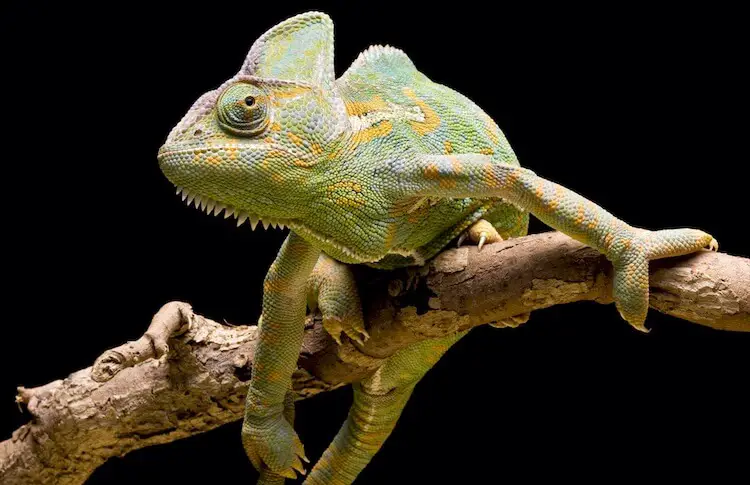
Veiled Chameleon Diet
Veiled Chameleons are omnivores and like to eat worms or insects such as roaches and crickets. It is best to feed a chameleon a diet that is close to what it would eat in the wild.
Chameleons under 12 months of age should eat 12 to 20 small crickets every day. Make sure the crickets are smaller than your chameleon’s head so he won’t choke.
Adults should eat 8 larger crickets every other day and food can be left out for about four hours.
Dust the crickets with a calcium supplement once a week. This supplement should be low in phosphorus and have no Vitamin D.
They also need a multivitamin that has preformed Vitamin A and a low amount of Vitamin D3. This should be given twice a month.
To make sure that your veiled chameleon is receiving a good amount of plant material you can either gut-load the insects you feed or directly feed cut-up fresh fruits and vegetables. They enjoy:
- Dandelion Leaves
- Lettuce
- Potted Hibiscus Plants
Veiled chameleons are known to suffer from dehydration and eye infections (more on this below). Both of these health issues can be solved with regular husbandry.
This lizard gets their water from morning dew and rain. To mimic this, spray down your cage in the evening when the lights are off for about one minute. You should not mist them during the daytime.
Misting daily allows water to collect in droplets that a veiled chameleon will then drink.
Veiled Chameleon Lifespan and Health
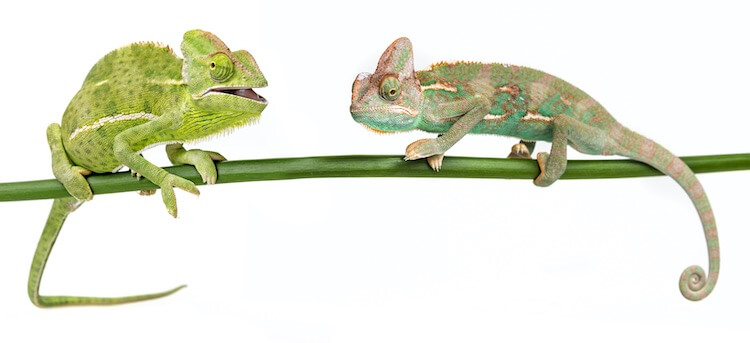
A veiled chameleon can live for between five to eight years in captivity. Females typically live closer to five years and males eight.
This species requires advanced husbandry because they can suffer from health issues in captivity:
| Veiled Chameleon Health Issues | |
|---|---|
| Respiratory and skin infections | Caused by a dirty cage and poor ventilation. Your chameleon will inhale too many dity particles and can become sick. Clean the cage regularly and make sure it has good ventilation. |
| Stomatitis (gum disease) | Occurs if your chameleon accidentally eats substrate that gets stuck in their mouth and becomes infected. |
| Impaction | Occurs if your chameleon accidentally eats substrate that gets stuck in their bowl causing impaction, or constipation. |
| Corneal damage | Caused by overexposure to UVB rays. This can be avoided by ensuring your chameleon has a good day/night cycle. |
| Parasitic infections | This happens when parasites bind to your lizard’s skin. This can be avoided by regularly misting your chameleon to let them properly wash. Periodic fecal exams can also help to catch these infections early. |
| Metabolic bone disease | Typically is caused by a lack of calcium in their diet. It results in bones that bend and have a strength deficiency. They may have deformed casques as they do not have the nutrients to fully grow it. |
| Hypovitaminosis A | A deficiency in vitamin A that is characterized by a very weak and lethargic pet. It results in slower growth rates, constantly closed eyes and/or an overbent spine. |
| Dystocia | The failure to lay eggs. |
Signs They Are Healthy
- Brightly colored.
- Rounded and clear eyes.
- Alertness.
- Strong grip.
Sickness Symptoms
- Dull, dark coloration (constantly).
- Wrinkly skin.
- Sunken eyes.
- Lack of appetite.
- A tremor or weakened stance.
Veiled Chameleon Habitat
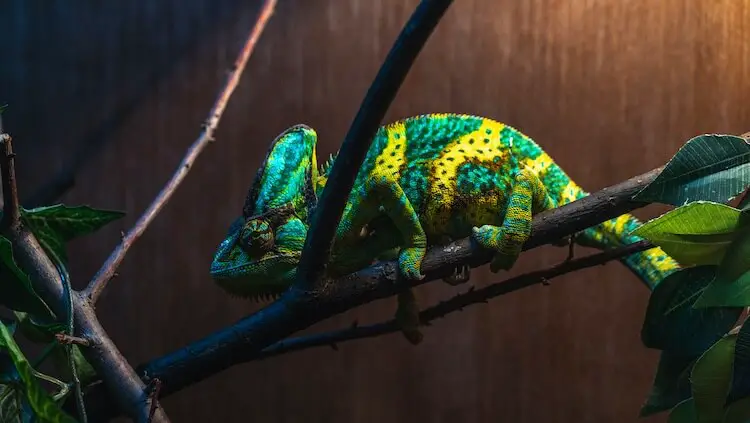
A veiled chameleon can live in many different types of habitat. They are native to Yemen and southern Saudi Arabia, but populations have become established in Florida and Hawaii.
They are arboreal and prefer to live in trees, bushes, or shrubs. You should make sure you include some type of tall plant matter in their cage.
A veiled chameleon cage should have lots of bushy plant matter to create an arboreal environment for them to hide in throughout the day.
This lizard prefers temperatures between 70 – 95°F during the day and slightly lower temperatures in the evening with a 10° – 15°F drop.
They also like a cage with a humidity of 40 – 60%.
Veiled Chameleon Cage Set Up
An adult should be placed in a cage that measures 2x2x4ft, has lots of foliage and is placed about 6ft off the ground. Juveniles can be placed in a 16x16x30″ screen enclosure but should be transferred to an adult enclosure at six months of age.
The best enclosure are plastic coated wire mesh (½in squared gaps) with wood or metal framing.
Fill their enclosure with lots of leafy branches and horizontal dowels for them to climb.
Because of the risk of impaction, it is best not to have substrate in their cage. Reptile carpet can be used, but watch for their claws getting stuck.
As cold blooded lizards, veiled chameleons need external heat sources in order to thermoregulate. No additional heating is required other than the lightbulbs for this reptile.
To achieve a temperature of 70 – 95°F during the day you will need to use an incandescent bulb (for UVA lighting) and a fluorescent hood with a UVB fluorescent light. The lights should be set to a 12-hour day and night cycle.
For basking, a ceramic reflector dome (with the UVA bulb) can be placed six inches above the highest basking perch. It should reach 90 – 95°F during the day.
Create a temperature gradient by leaving lights at the top of their enclosure. This will naturally create a cooler area at the bottom.
Humidity should be kept between 40-60%.
You can use a humidistat and set up an automatic spray system to control humidity. Alternatively you can mist down the plants with a pressurized spray bottle three times a day.
A chameleon occasionally needs to clean themselves in the rain. This can be accomplished in captivity by holding a longer misting session (~3 minutes) once a week.
Cage Cleaning
Spot clean their cage daily and remove fecal matter, dead crickets, and dead leaves.
When cleaning make sure you inspect their feces.
Healthy feces are dark brown or black and have a white section. They are round or ovular and have no smell. If it is runny, too dry, not uniform in shape, or has a smell, you should take their feces to a vet for testing.
Once every two weeks wash the base of the cage with soap and water. Every two months wash any plastic decorations or plants.
Typical Behavior
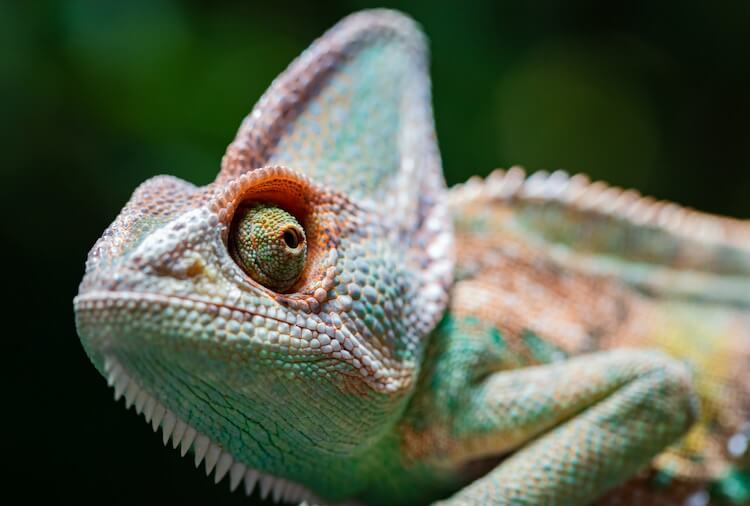
Veiled chameleons are primarily solitary reptiles and only tolerate each other when breeding – Chameleons like their privacy.
Because of how territorial they are this lizard will not want to be housed with any other reptiles.
In captivity they will be on their basking perch early in the morning and then move to the leaves as the day progresses.
They enjoy having spaces to hide. As long as you don’t spook them with any sudden movements you will be able to watch your veiled chameleon during feeding, washing, or basking.
Males especially are extremely territorial.
When faced with a predator they will engage in aggressive behaviors such as extending their legs and throat region to appear larger and brightening their color. They fight by jabbing their head out to bite or poke their enemy.
In the wild chameleons change their skin color in an attempt to scare their opponent off.
When submissive they shrink and adopt duller colors.
Why Do Veiled Chameleons Hiss?
Chameleons will occasionally use verbal cues like hissing as an aggressive behavior. They have great eyesight but bad senses of hearing and smell, so most of their communication is visual, including changes in size and coloration.
They can also sense vibrations in plants or other materials to track prey.
Handling Advice and Tips
While some lizards can be handled veiled chameleons should not be handled.
Make sure you respect your chameleon’s boundaries and handle it only when necessary.
Because of their susceptibility to parasites be sure to wash your hands with soap and water before and after handling.
Baby Veiled Chameleons
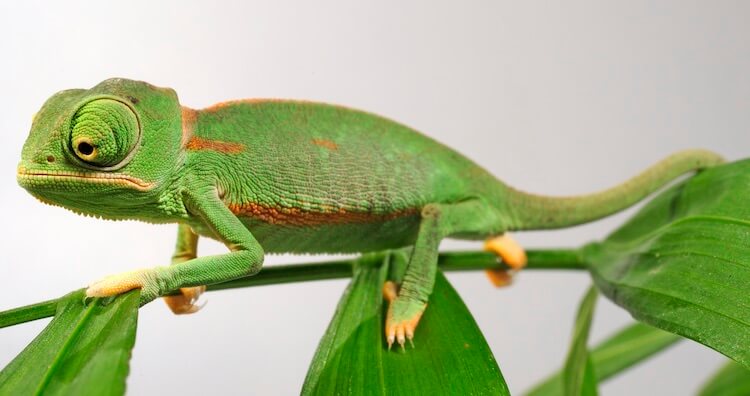
How Much Does A Veiled Chameleon Cost?
Their price is drive by age and coloration. A baby chameleon cost between $30 – $50, a juvenile is $50 – $150 and adults are $150 – $200.
However, it is not just the adoption fee you will need to pay. Cage set up costs can range from $100 – $500 and it will cost $50 a month to cover recurring feeding costs.
Make sure you only purchase a healthy reptile.
They should have a crest proportional to their head, bright and clear eyes, a closed mouth when resting and should be able to stand steadily on four straight legs.
How To Sex A Veiled Chameleon
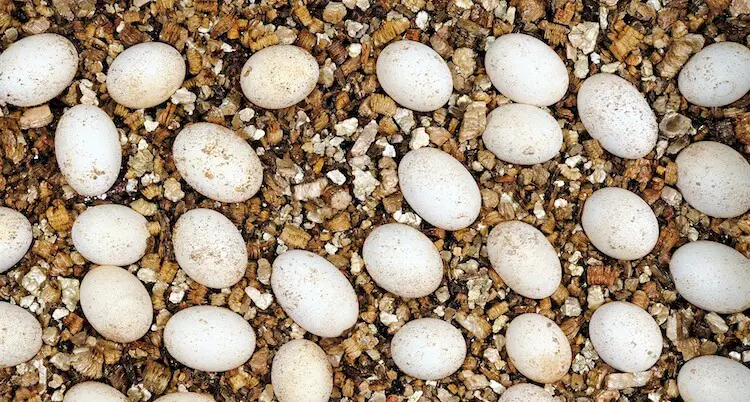
A gravid female has vivid blue spots on her dorsum.
Males are very persistent in courting and display themselves from the side to maximize their size.
A pleased female will remain dull-colored and passive, while a female rejecting her suitor will remain bright and active.
After the first steps of courtship a male will try to mount. Mating can last from a few minutes to an hour.
A female will only lay her eggs in tunneled-out substrate. After all the 40-50 eggs are laid, incubate them in the dark at 81°F and 95% humidity. Sex ratios are not affected by incubation temperature or the temperature of the tank. They hatch in ~200 days.
Babies are born a bright, pale green and should be placed in a 10-gallon nursery a day after birth.
Half-fill the aquarium with safe plants at different heights. Use a hood with a fluorescent bulb at one end of the nursery to provide UVB and maintain a temperature between 70° – 83°F.
| Veiled Chameleon Facts | |
|---|---|
| Common Name | Veiled Chameleon |
| Scientific Name | Chamaeleo calyptratus |
| Price | $50+ |
| Size | 10 – 24 inches (males are slightly bigger) |
| Lifespan | 5 – 8 years (males live longer) |
| Diet | Mainly insects |
| Tank Size | 2x2x4ft with lots of foliage |
| Humidity & Temperature | Temperature: 70° – 95°F Humidity: 40 – 60% |
| Popular Alternatives | Jackson’s Chameleon Panther Chameleon |
Summary
A Veiled Chameleon is the best introduction to raising chameleons, as other species are more expensive and difficult to care for.
Raising a veiled chameleon is very rewarding provided you are willing to put in the time and are not looking for a reptile that enjoys being handled.
They are vividly colored lizards that are beautiful to observe.
Although veiled chameleons are the easiest type of chameleon to care for they still require an experienced herpetologist. They need constant misting, good ventilation, a 12-hour day and night cycle, and regular feeding.
Let us know your experiences in the comments below.








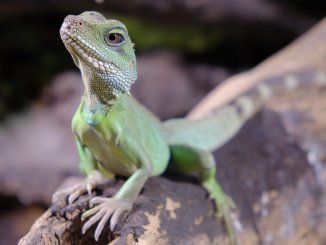
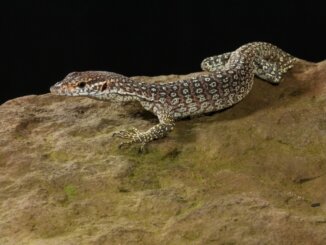
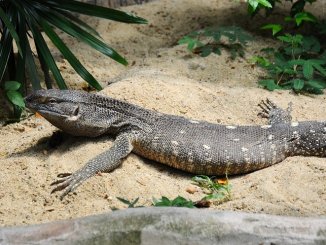

My son has a Veiled Chameleon (Chamaeleo calyptratus)
And I think he has a broken leg ?
How or what do I do or go about it
They can indeed incur in injuries and a vet may treat it with a cast (you can make a DIY cast, but this requires some research and abilities).
Check the grip on his leg, because that’s the most important aspect of injury. But please also keep in mind that breaking a leg might not just be a misfortune: handling the pet with great care and at ground level to avoid him falling are the first and most important notion to keep in mind. However, a common condition which causes injuries down the road, is the metabolic bone disease (MBD), or a precursor of it, which is caused by Calcium deficiency, itself caused by sub-optimal UVB exposure, and that can cause bones to become brittle.
I am a first time veiled chameleon owner with the jitters. Your site is the first to mention continuous dark color as a sign of illness. I’m afraid a started out getting some instructions backwards, and for the first two days inundated the 4’x 2′ x 2′ screened habitat with misting and then wrapping it to try to attain a high humidity. I know – BAD. I can’t tell you where or how I got the idea for 80%, but I must have misunderstood a pet store employee. Also, I’m confused about lighting temp. I’ve read ranges from 80 to 100 degrees, and have gone from a 100 watt to 150 watt and back again, the higher wattage using a deep dome ceramic fixture (the 100 is now in the deep dome, further from the top screen. Feeding: again, all over the map, from every other day to 6 crickets a day, but only fortified once/wk, warry of too much vit A, and “Not to worry, err on the side of more than too little. The pet store guy, who raises these, gave me a bark substrate for keeping up the humidity! (Maybe he’s the guy I got the 80% humidity idea from.) Anyway, I need help from a community of experienced piebald veiled chameleon owners! P.S. I don’t have a website.
Well, could it be that either you or the guy simply picked the wrong chameleon species? Many chameleons live in much wetter climates than the Veiled Chameleon which is from the Arabian peninsula. Many of the things you did seem appropriate for other chameleon species. Anyway, to answer some of your questions: 80-100 degrees seems like an appropriate range, but make sure it is not always in the lower or higher end of the spectrum and provide some day/night difference. Humidity definitely too high. Get a hygrometer and keep it below 60%. Do not worry about substrate, they won’t ingest it, especially if you can provide arboreal features for him to climb on (very important for his well being). You don’t need to feed everyday: if the appetite is good during a feeding session (meaning 6-8 crickets or similar) you can skip the next day. Alternatively aim for 3 crickets a day. Provide supplements once or twice per week. Hope this helps, let me know!